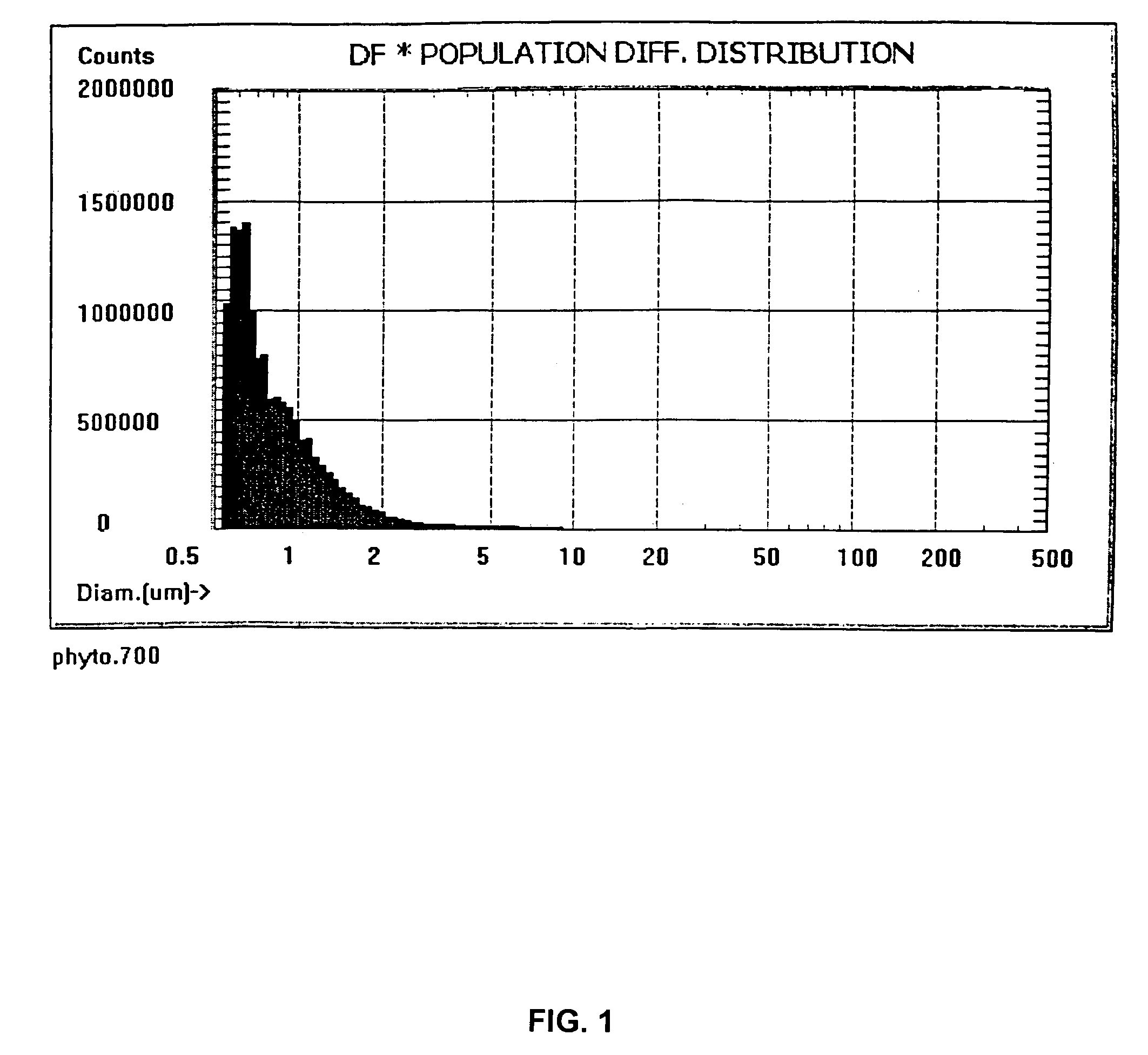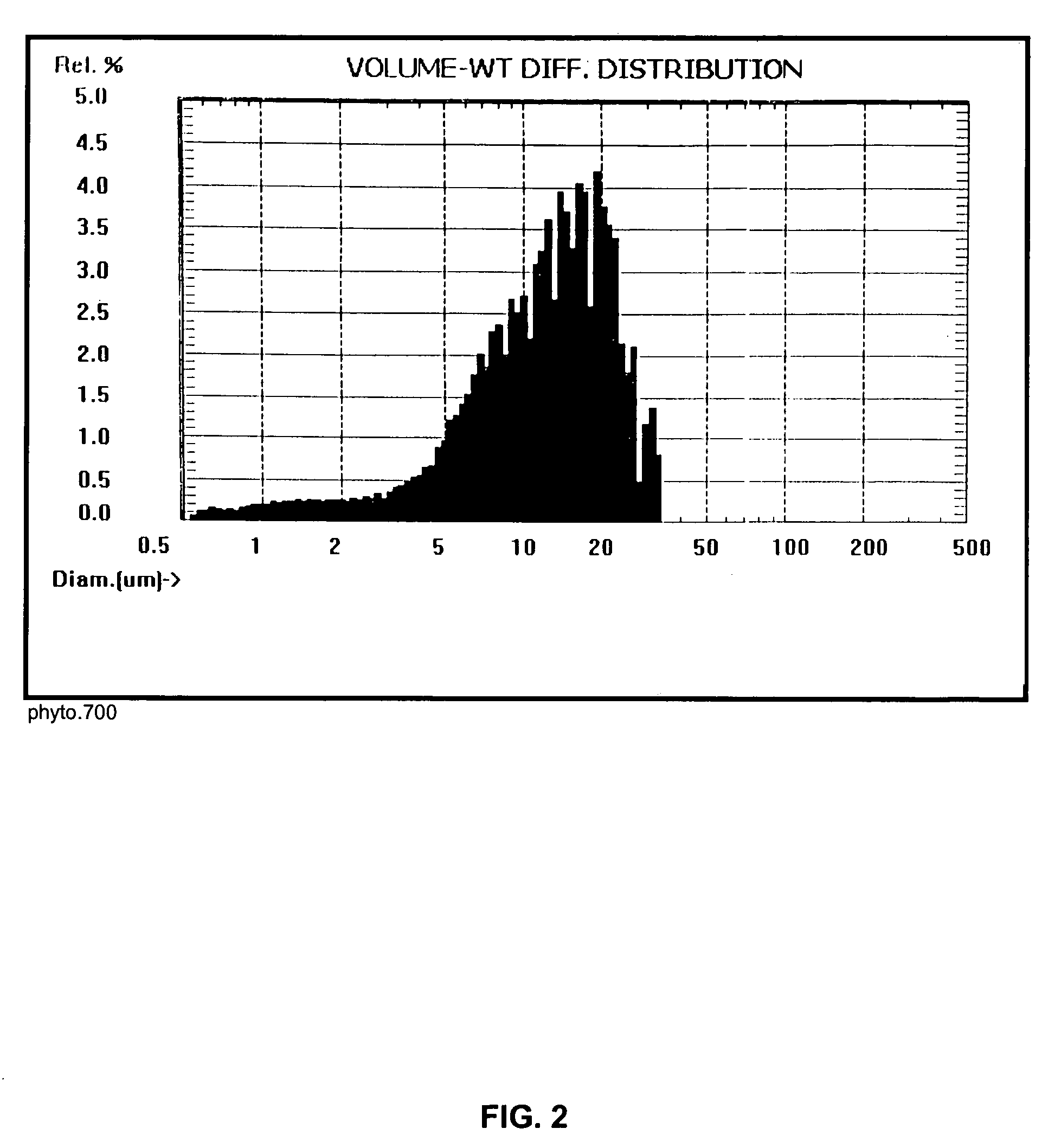Beverages containing plant sterols
a technology of plant sterols and beverages, applied in the field of water compositions, can solve the problems of low serum cholesterol, difficult preparation of products suitable for human and veterinary consumption that contain plant sterols or stanols, and product acceptance that has never received widespread consumer acceptance, so as to prevent microbial spoilage, increase the volume of sinking pulp, and stable dispersion of plant sterols
- Summary
- Abstract
- Description
- Claims
- Application Information
AI Technical Summary
Benefits of technology
Problems solved by technology
Method used
Image
Examples
example 1
[0073]Combining the following components provided a base mixture of hydrophobic plant sterol with an aqueous material before subsequent processing to form a first dispersion.
[0074]The composition was formulated to obtain the following:
[0075]
Base IngredientsDesired Volume2.2GallonsWater2,079.4gramsOrange Concentrate7,837.0gramsOrange Flavor119.6gramsOrange Oil6.3gramsPlant sterol198.1gramsTotal10,240.8gramsFinished ProductIngredientsDesired Volume4.4gallonsWater13,262.9gramsBase4,178.3grams
[0076]
Base SpecificationsOPT.MIN.MAX.Percent Soluble Solids49.749.450.5Refractometer ° Brix49.849.550.6% Acid w / w as citric2.82.53.1° Brix / acid ratio17.515.719.8
[0077]The substantially stable dispersion of the oleophilic plant sterol and the orange juice concentrate as the aqueous material had a concentration of 48.9° Brix (refractometer Brix, corrected for acid).
[0078]The mixture was blended using an Arde-Barinco Model No. CJ-4 high shear mixer at 7000 rpm for about 15 minutes to produce a first d...
example 2
[0082]Combining the following components provided a base mixture of hydrophobic plant sterol with an aqueous material before subsequent processing to form a first dispersion.
[0083]The composition was formulated to obtain the following:
[0084]
Base IngredientsDesired Volume0.8GallonsWater180.2gramsOrange Concentrate3,363.0grams1Orange Flavor53.1gramsOrange Oil2.7gramsPlant sterol76.7grams2Total3,675.5grams1Refractometer ° Brix, 65 (corrected for acid); acid, 3.71% (wt. / wt.).2ADM 09 / 2001 consisting essentially of betasitosterol, betasitostanol, campesterol, campestanol, stigmasterol, spinosterol, avenasterol, or brassicasterol having a particle size of from about 0.5 microns to about 30 microns.
[0085]Finished Product Ingredients
[0086]
Desired Volume4.8 gallonsWater4.1 gallonsBase0.8 gallons
[0087]
Base SpecificationsOPT.MIN.MAX.Percent Soluble Solids61.661.162.4Refractometer ° Brix61.660.762.0% Acid w / w as citric3.43.13.7° Brix / acid ratio18.016.420.0
[0088]The substantially stable dispersio...
example 3
[0093]Combining the following components provided a base mixture of hydrophobic plant sterol with an aqueous material before subsequent processing to form a first dispersion.
[0094]The composition was formulated to obtain the following:
[0095]
Base IngredientsDesired Volume2,000.0GallonsWater4,158.8poundsOrange Concentrate15,674.0poundsOrange Flavor239.2poundsOrange Oil12.7poundsPlant sterol396.2poundsTotal20,480.9poundsFinished Product IngredientsDesired volume1,000gallonsWater6,631.5poundsBase2089.1pounds
[0096]
Base SpecificationsOPT.MIN.MAX.Percent Soluble Solids49.749.450.5Refractometer ° Brix49.849.550.6% Acid w / w as citric2.82.53.1° Brix / acid ratio17.515.719.8
[0097]The substantially stable dispersion of the oleophilic plant sterol and the orange juice concentrate as the aqueous material had a concentration of 50.1° Brix (refractometer Brix, corrected for acid).
[0098]The mixture was blended in a 2200 gallon batch tank with constant agitation prior to adding the plant sterols or sta...
PUM
 Login to View More
Login to View More Abstract
Description
Claims
Application Information
 Login to View More
Login to View More - R&D
- Intellectual Property
- Life Sciences
- Materials
- Tech Scout
- Unparalleled Data Quality
- Higher Quality Content
- 60% Fewer Hallucinations
Browse by: Latest US Patents, China's latest patents, Technical Efficacy Thesaurus, Application Domain, Technology Topic, Popular Technical Reports.
© 2025 PatSnap. All rights reserved.Legal|Privacy policy|Modern Slavery Act Transparency Statement|Sitemap|About US| Contact US: help@patsnap.com


